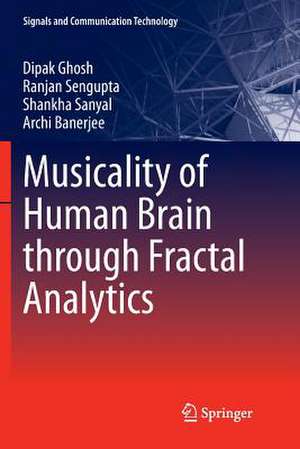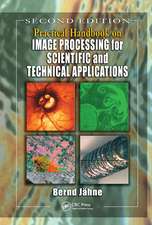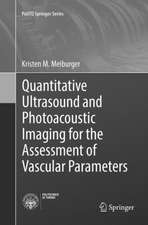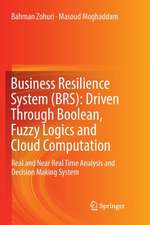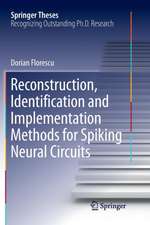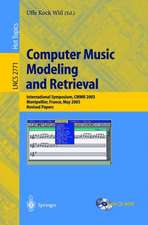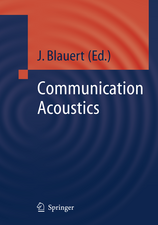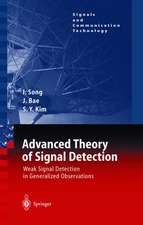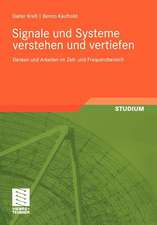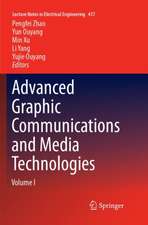Musicality of Human Brain through Fractal Analytics: Signals and Communication Technology
Autor Dipak Ghosh, Ranjan Sengupta, Shankha Sanyal, Archi Banerjeeen Limba Engleză Paperback – 26 ian 2019
| Toate formatele și edițiile | Preț | Express |
|---|---|---|
| Paperback (1) | 638.24 lei 6-8 săpt. | |
| Springer Nature Singapore – 26 ian 2019 | 638.24 lei 6-8 săpt. | |
| Hardback (1) | 644.49 lei 6-8 săpt. | |
| Springer Nature Singapore – 5 oct 2017 | 644.49 lei 6-8 săpt. |
Din seria Signals and Communication Technology
- 18%
 Preț: 952.89 lei
Preț: 952.89 lei - 18%
 Preț: 1559.80 lei
Preț: 1559.80 lei - 17%
 Preț: 361.80 lei
Preț: 361.80 lei - 18%
 Preț: 811.61 lei
Preț: 811.61 lei - 15%
 Preț: 585.26 lei
Preț: 585.26 lei - 18%
 Preț: 727.97 lei
Preț: 727.97 lei - 15%
 Preț: 585.90 lei
Preț: 585.90 lei -
 Preț: 393.35 lei
Preț: 393.35 lei - 20%
 Preț: 1002.73 lei
Preț: 1002.73 lei - 15%
 Preț: 641.71 lei
Preț: 641.71 lei - 20%
 Preț: 338.92 lei
Preț: 338.92 lei - 18%
 Preț: 1579.66 lei
Preț: 1579.66 lei - 18%
 Preț: 896.08 lei
Preț: 896.08 lei - 18%
 Preț: 847.11 lei
Preț: 847.11 lei - 18%
 Preț: 1234.77 lei
Preț: 1234.77 lei - 18%
 Preț: 905.54 lei
Preț: 905.54 lei - 15%
 Preț: 646.43 lei
Preț: 646.43 lei - 20%
 Preț: 662.48 lei
Preț: 662.48 lei - 15%
 Preț: 641.20 lei
Preț: 641.20 lei - 18%
 Preț: 1847.84 lei
Preț: 1847.84 lei - 18%
 Preț: 946.24 lei
Preț: 946.24 lei - 18%
 Preț: 1241.10 lei
Preț: 1241.10 lei - 20%
 Preț: 649.43 lei
Preț: 649.43 lei - 20%
 Preț: 993.28 lei
Preț: 993.28 lei - 18%
 Preț: 940.57 lei
Preț: 940.57 lei - 18%
 Preț: 1389.30 lei
Preț: 1389.30 lei - 20%
 Preț: 1003.50 lei
Preț: 1003.50 lei - 18%
 Preț: 953.52 lei
Preț: 953.52 lei - 20%
 Preț: 1001.16 lei
Preț: 1001.16 lei - 18%
 Preț: 1415.36 lei
Preț: 1415.36 lei - 15%
 Preț: 653.33 lei
Preț: 653.33 lei - 15%
 Preț: 645.60 lei
Preț: 645.60 lei - 15%
 Preț: 637.28 lei
Preț: 637.28 lei - 18%
 Preț: 948.79 lei
Preț: 948.79 lei - 18%
 Preț: 945.62 lei
Preț: 945.62 lei - 18%
 Preț: 836.36 lei
Preț: 836.36 lei - 18%
 Preț: 1225.46 lei
Preț: 1225.46 lei - 15%
 Preț: 635.01 lei
Preț: 635.01 lei - 15%
 Preț: 639.25 lei
Preț: 639.25 lei - 15%
 Preț: 646.30 lei
Preț: 646.30 lei - 15%
 Preț: 639.25 lei
Preț: 639.25 lei - 15%
 Preț: 712.36 lei
Preț: 712.36 lei - 20%
 Preț: 1006.12 lei
Preț: 1006.12 lei - 18%
 Preț: 970.56 lei
Preț: 970.56 lei
Preț: 638.24 lei
Preț vechi: 750.88 lei
-15% Nou
Puncte Express: 957
Preț estimativ în valută:
122.14€ • 127.05$ • 100.84£
122.14€ • 127.05$ • 100.84£
Carte tipărită la comandă
Livrare economică 14-28 aprilie
Preluare comenzi: 021 569.72.76
Specificații
ISBN-13: 9789811348945
ISBN-10: 9811348944
Pagini: 232
Ilustrații: XVII, 232 p. 119 illus., 111 illus. in color.
Dimensiuni: 155 x 235 mm
Greutate: 0.36 kg
Ediția:Softcover reprint of the original 1st ed. 2018
Editura: Springer Nature Singapore
Colecția Springer
Seria Signals and Communication Technology
Locul publicării:Singapore, Singapore
ISBN-10: 9811348944
Pagini: 232
Ilustrații: XVII, 232 p. 119 illus., 111 illus. in color.
Dimensiuni: 155 x 235 mm
Greutate: 0.36 kg
Ediția:Softcover reprint of the original 1st ed. 2018
Editura: Springer Nature Singapore
Colecția Springer
Seria Signals and Communication Technology
Locul publicării:Singapore, Singapore
Cuprins
Introduction.- Methodology.- Emotions from Hindustani Classical Music: An EEG based study with evidence of neural hysteresis.- Musical perception and visual imagery: Do musicians visualize while performing?.- Tanpura drone and brain dynamics: How a simple acoustic signal affects brain rhythms.- In search of universality of music: effect of cross cultural instrumental clips.- Gestalt phenomenon in music: which frequencies do we hear?.- Quantification of musical emotion with neural jitter-shimmer: novel study with hindustani music.- An approach to encapsulate improvisation in hindustani classical music.- Ambiguity in hindustani classical music: development of an automated algorithm to asses ambiguity.- Computing the pitch of an EEG signal: a new paradigm in analysis of bio-signals.- Epilogue.
Notă biografică
Prof. Dipak Ghosh, a University Gold medalist and a PhD in the area of High Energy Physics, published more than four hundred papers in international journals across the world. He was the Professor and Dean of the faculty of Science, Jadavpur University. He supervised the PhD thesis of 70 students and still continuing in doing so. From 2004, he started to work in the area of physics and music and established the Sir C V Raman Centre for Physics and Music, Jadavpur University. He worked as the coordinator of the Centre till his retirement in 2010. In this connection he has published more than hundred papers on music information retrieval and clinical psychology. Presently he is the Emeritus Professor at the Centre. His area interest for the last three years is to study the effect of music on human brain from the neuro-physics perspective. Prof. Ghosh is the recipient of many awards including Sir C.V. Raman Award by U.G.C, Govt. of India for his in-depth research work in various disciplines.
Mr. Shankha Sanyal is currently pursuing Ph.D in the field of Cognitive Neurophysics at Sir C.V. Raman Centre for Physics and Music, Jadavpur University. He completed Post Graduation in Physics from Jadavpur University, Kolkata in the year 2012. He is also a Graduate from Jadavpur University. He has been awarded the prestigious S.N. Bose Research Fellowship Award by Department of Science and Technology, Govt. of West Bengal. He is also a CSIR Senior Research Fellow Awardee, Govt. of India. He has more than 50 publications in different journals of international repute and Conference proceedings during his tenure of Ph.D. His main research interests involve emotion recognition and improvisational cues from different renditions of Hindustani Classical music as well as biomedical signal processing algorithms.
Dr. Ranjan Sengupta, a PhD in High energy Physics, was the Senior Research Scientist and Head, Scientific Research Department, ITC Sangeet Research Academy, Kolkata for 27 years. From 2010 he is associated with Sir C V Raman Centre of Physics and Music, Jadavpur University, Kolkata as a Scientific Consultant. He has published nearly 200 papers in the area of High Energy Physics, Music Signal Processing, Speaker Recognition, Music Information Retrieval, Music Perception and Cognition and Music Acoustics. He is a recipient of Sir C V Raman Award from Acoustical Society of India. A Life Fellow of the Acoustical Society of India, he is also a life member of Indian Physical Society and Indian Association for the Cultivation of Science, Kolkata.
Ms. Archi Banerjee is currently pursuing Ph.D in the field of Music Cognition at Sir C.V. Raman Centre for Physics and Music, Jadavpur University. She completed her Post Graduation in Physics from Jadavpur University, Kolkata in the year 2012. She did her Graduation also from Jadavpur University. She has been awarded the prestigious Inspire Scholarship by the Depart
ment of Science and Technology, Government of India. She is a student of music for the past 15 years at Shrutinandan school of Music under the patronage of her Guru Pt. Ajoy Chakraborty. She has published more than 50 high quality papers in peer-reviewed International Journals and Conferences in the domain of music signal processing and cognitive neuroscience.Textul de pe ultima copertă
This book provides a comprehensive overview of how fractal analytics can lead to the extraction of interesting features from the complex electroencephalograph (EEG) signals generated by Hindustani classical music. It particularly focuses on how the brain responses to the emotional attributes of Hindustani classical music that have been long been a source of discussion for musicologists and psychologists. Using robust scientific techniques that are capable of looking into the most intricate dynamics of the complex EEG signals, it deciphers the human brain’s response to different ragas of Hindustani classical music, shedding new light on what happens inside the performer’s brain when they are mentally composing the imagery of a particular raga. It also explores the much- debated issue in the musical fraternity of whether there are any universal cues in music that make it identifiable for people throughout the world, and if so, what are the neural correlates associated with the universalcues? This book is of interest to researchers and scholars of music and the brain, nonlinear science, music cognition, music signal processing and music information retrieval. In addition, researchers in the field of nonlinear biomedical signal processing and music signal analysis benefit from this book.
Caracteristici
Broadens our understanding of the nonlinear processing of music and music-induced electroencephalograph (EEG) signals Offers a simplified picture of how music signals are processed in the brain Enriches our understanding of musicality and the brain Includes supplementary material: sn.pub/extras
